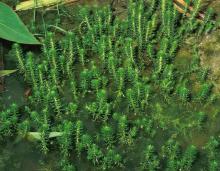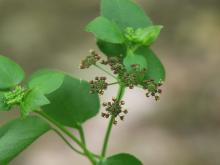Wildflowers, Grasses and Other Nonwoody Plants
Media

Species Types
Scientific Name
Securigera varia (formerly Coronilla varia)
Description
In summer, you’re almost guaranteed to see big colonies of crown vetch along Missouri's highways. This weedy nonnative plant stabilizes the dirt after road construction but degrades our natural ecosystems.
Media

Species Types
Scientific Name
Oxalis violacea
Description
Missouri has one introduced and four native wood sorrels. Violet wood sorrel is the only one that has magenta or lavender flowers.
Media

Species Types
Scientific Name
Trifolium stoloniferum
Description
Running buffalo clover spreads by sending out long, creeping runners. Now endangered, this native perennial once flourished along streams and buffalo trails throughout the grasslands of the eastern and central United States.
Media

Species Types
Scientific Name
Delphinium carolinianum
Description
Small blue, lavender, or white flowers shaped like cornucopias dance along the tall stems of this Carolina larkspur, which grows in prairies and grasslands.
Media

Species Types
Scientific Name
Astragalus crassicarpus (formerly A. mexicanus)
Description
Ground plum is a legume that bears plumlike, edible fruits. Its short, spikelike clusters of pea flowers can be white, cream, yellow, pink, or violet.
Media

Species Types
Scientific Name
Lespedeza virginica
Description
A bushy native perennial legume with small clusters of pink flowers, slender bush clover provides nectar for numerous insects. Several types of birds eat the seeds, and many mammals eat the foliage.
Media

Species Types
Scientific Name
Vicia villosa
Description
Branching, spreading, and tangling, hairy vetch forms dense colonies along highways and other disturbed sites. This softly hairy ground-covering plant has one-sided clusters of purple pea flowers.
Species Types
Scientific Name
Orbexilum onobrychis (formerly Psoralea onobrychis)
Description
Looking absolutely nothing like a grass, French grass, a legume, bears upright spikes of pale purple flowers on long stems from the leaf axils. The leaves are trifoliate, resembling those of soybeans.
Media

Species Types
Scientific Name
Myriophyllum spp.
Description
Water milfoils are feathery aquatic plants that grow rooted in shallow water. Their tips emerge above the waterline and bear bladelike, toothed leaves.
Media

Species Types
Scientific Name
Thaspium trifoliatum
Description
One of our more challenging plants to identify, meadow parsnip looks an awful lot like golden Alexanders. But you can do it! Look closely at the flower clusters and at the edges of the leaves, and then check the seeds.
See Also
About Wildflowers, Grasses and Other Nonwoody Plants in Missouri
A very simple way of thinking about the green world is to divide the vascular plants into two groups: woody and nonwoody (or herbaceous). But this is an artificial division; many plant families include some species that are woody and some that are not. The diversity of nonwoody vascular plants is staggering! Think of all the ferns, grasses, sedges, lilies, peas, sunflowers, nightshades, milkweeds, mustards, mints, and mallows — weeds and wildflowers — and many more!





















